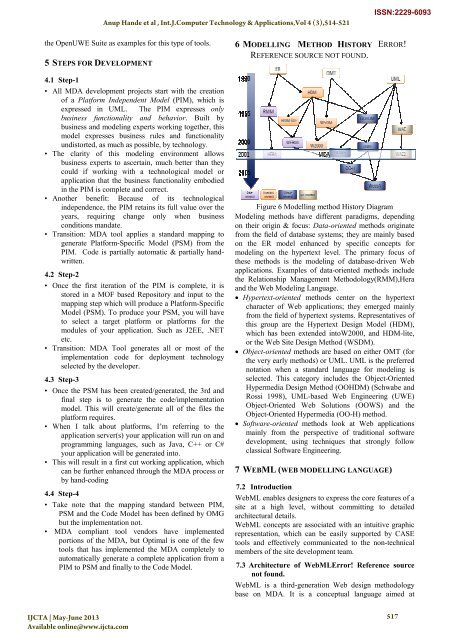Survey of Existing Web Models Techniques to Design Web Application
Survey of Existing Web Models Techniques to Design Web Application
Survey of Existing Web Models Techniques to Design Web Application
You also want an ePaper? Increase the reach of your titles
YUMPU automatically turns print PDFs into web optimized ePapers that Google loves.
Anup Hande et al , Int.J.Computer Technology & <strong>Application</strong>s,Vol 4 (3),514-521<br />
ISSN:2229-6093<br />
the OpenUWE Suite as examples for this type <strong>of</strong> <strong>to</strong>ols.<br />
5 STEPS FOR DEVELOPMENT<br />
4.1 Step-1<br />
• All MDA development projects start with the creation<br />
<strong>of</strong> a Platform Independent Model (PIM), which is<br />
expressed in UML. The PIM expresses only<br />
business functionality and behavior. Built by<br />
business and modeling experts working <strong>to</strong>gether, this<br />
model expresses business rules and functionality<br />
undis<strong>to</strong>rted, as much as possible, by technology.<br />
• The clarity <strong>of</strong> this modeling environment allows<br />
business experts <strong>to</strong> ascertain, much better than they<br />
could if working with a technological model or<br />
application that the business functionality embodied<br />
in the PIM is complete and correct.<br />
• Another benefit: Because <strong>of</strong> its technological<br />
independence, the PIM retains its full value over the<br />
years, requiring change only when business<br />
conditions mandate.<br />
• Transition: MDA <strong>to</strong>ol applies a standard mapping <strong>to</strong><br />
generate Platform-Specific Model (PSM) from the<br />
PIM. Code is partially au<strong>to</strong>matic & partially handwritten.<br />
4.2 Step-2<br />
• Once the first iteration <strong>of</strong> the PIM is complete, it is<br />
s<strong>to</strong>red in a MOF based Reposi<strong>to</strong>ry and input <strong>to</strong> the<br />
mapping step which will produce a Platform-Specific<br />
Model (PSM). To produce your PSM, you will have<br />
<strong>to</strong> select a target platform or platforms for the<br />
modules <strong>of</strong> your application. Such as J2EE, .NET<br />
etc.<br />
• Transition: MDA Tool generates all or most <strong>of</strong> the<br />
implementation code for deployment technology<br />
selected by the developer.<br />
4.3 Step-3<br />
• Once the PSM has been created/generated, the 3rd and<br />
final step is <strong>to</strong> generate the code/implementation<br />
model. This will create/generate all <strong>of</strong> the files the<br />
platform requires.<br />
• When I talk about platforms, I’m referring <strong>to</strong> the<br />
application server(s) your application will run on and<br />
programming languages, such as Java, C++ or C#<br />
your application will be generated in<strong>to</strong>.<br />
• This will result in a first cut working application, which<br />
can be further enhanced through the MDA process or<br />
by hand-coding<br />
4.4 Step-4<br />
• Take note that the mapping standard between PIM,<br />
PSM and the Code Model has been defined by OMG<br />
but the implementation not.<br />
• MDA compliant <strong>to</strong>ol vendors have implemented<br />
portions <strong>of</strong> the MDA, but Optimal is one <strong>of</strong> the few<br />
<strong>to</strong>ols that has implemented the MDA completely <strong>to</strong><br />
au<strong>to</strong>matically generate a complete application from a<br />
PIM <strong>to</strong> PSM and finally <strong>to</strong> the Code Model.<br />
IJCTA | May-June 2013<br />
Available online@www.ijcta.com<br />
6 MODELLING METHOD HISTORY ERROR!<br />
REFERENCE SOURCE NOT FOUND.<br />
Figure 6 Modelling method His<strong>to</strong>ry Diagram<br />
Modeling methods have different paradigms, depending<br />
on their origin & focus: Data-oriented methods originate<br />
from the field <strong>of</strong> database systems; they are mainly based<br />
on the ER model enhanced by specific concepts for<br />
modeling on the hypertext level. The primary focus <strong>of</strong><br />
these methods is the modeling <strong>of</strong> database-driven <strong>Web</strong><br />
applications. Examples <strong>of</strong> data-oriented methods include<br />
the Relationship Management Methodology(RMM),Hera<br />
and the <strong>Web</strong> Modeling Language.<br />
• Hypertext-oriented methods center on the hypertext<br />
character <strong>of</strong> <strong>Web</strong> applications; they emerged mainly<br />
from the field <strong>of</strong> hypertext systems. Representatives <strong>of</strong><br />
this group are the Hypertext <strong>Design</strong> Model (HDM),<br />
which has been extended in<strong>to</strong>W2000, and HDM-lite,<br />
or the <strong>Web</strong> Site <strong>Design</strong> Method (WSDM).<br />
• Object-oriented methods are based on either OMT (for<br />
the very early methods) or UML. UML is the preferred<br />
notation when a standard language for modeling is<br />
selected. This category includes the Object-Oriented<br />
Hypermedia <strong>Design</strong> Method (OOHDM) (Schwabe and<br />
Rossi 1998), UML-based <strong>Web</strong> Engineering (UWE)<br />
Object-Oriented <strong>Web</strong> Solutions (OOWS) and the<br />
Object-Oriented Hypermedia (OO-H) method.<br />
• S<strong>of</strong>tware-oriented methods look at <strong>Web</strong> applications<br />
mainly from the perspective <strong>of</strong> traditional s<strong>of</strong>tware<br />
development, using techniques that strongly follow<br />
classical S<strong>of</strong>tware Engineering.<br />
7 WEBML (WEB MODELLING LANGUAGE)<br />
7.2 Introduction<br />
<strong>Web</strong>ML enables designers <strong>to</strong> express the core features <strong>of</strong> a<br />
site at a high level, without committing <strong>to</strong> detailed<br />
architectural details.<br />
<strong>Web</strong>ML concepts are associated with an intuitive graphic<br />
representation, which can be easily supported by CASE<br />
<strong>to</strong>ols and effectively communicated <strong>to</strong> the non-technical<br />
members <strong>of</strong> the site development team.<br />
7.3 Architecture <strong>of</strong> <strong>Web</strong>MLError! Reference source<br />
not found.<br />
<strong>Web</strong>ML is a third-generation <strong>Web</strong> design methodology<br />
base on MDA. It is a conceptual language aimed at<br />
517
















